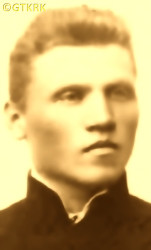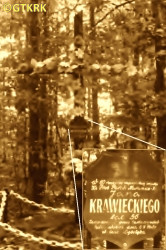Roman Catholic
St Sigismund parish
05-507 Słomczyn
85 Wiślana Str.
Konstancin deanery
Warsaw archdiocese, Poland
full list:
displayClick to display full list

searchClick to search full list by categories
wyświetlKliknij by wyświetlić pełną listę po polsku

szukajKliknij by przeszukać listę wg kategorii po polsku

Martyrology of the clergy — Poland
XX century (1914 – 1989)
personal data
surname
KRAWIECKI
forename(s)
John (pl. Jan)
function
diocesan priest
creed
Latin (Roman Catholic) Church RCmore on
en.wikipedia.org
[access: 2014.09.21]
diocese / province
Częstochowa diocesemore on
en.wikipedia.org
[access: 2013.05.19]
Włocławek i.e. Kalisz diocesemore on
pl.wikipedia.org
[access: 2019.10.13]
date and place
of death
06.05.1940

Dębołękatoday: Brzeźnio gm., Sieradz pov., Łódź voiv., Poland
more on
en.wikipedia.org
[access: 2022.01.28]
alt. dates and places
of death
20.05.1940, 31.05.1940, 06.06.1941
details of death
After German and Russian invasion of Poland in 09.1939 and start of the World War II, after start of German occupation, for the first time arrested by the Germans on 20.09.1939.
Held as a hostage but after some time released.
Next time arrested by the Germans on 06.05.1940 and accused of hoarding weaponry (prob. planted by the Germans themselves).
On the same day transported to Sieradz (c. 40 km from Naramice), a from there to the Brzeźnio parish and there, in a nearby forest, murdered with two shots to the head.
cause of death
murder
perpetrators
Germans
sites and events
Collective responsibility („Hostages”)Click to display the description, Ribbentrop‐MolotovClick to display the description, Pius XI's encyclicalsClick to display the description
date and place
of birth
27.12.1883

Pierocicetoday: Działoszyce gm., Pińczów pov., Holy Cross voiv., Poland
more on
en.wikipedia.org
[access: 2022.01.28]
presbyter (holy orders)
ordination
15/29.06.1922

Włocławektoday: Włocławek city pov., Kuyavia‐Pomerania voiv., Poland
more on
en.wikipedia.org
[access: 2021.12.18]
positions held
1935 – 1940
administrator — Naramicetoday: Biała Druga gm., Wieluń pov., Łódź voiv., Poland
more on
en.wikipedia.org
[access: 2020.12.11] ⋄ All the Saints RC church ⋄ St Rock the Confessor RC parish ⋄ Wieruszówtoday: Wieruszów gm., Wieruszów pov., Łódź voiv., Poland
more on
en.wikipedia.org
[access: 2020.12.11] RC deanery
1928 – 1935
parish priest — Skarżycetoday: district of Zawiercie, Zawiercie urban gm., Zawiercie pov., Silesia voiv., Poland
more on
en.wikipedia.org
[access: 2022.01.28] ⋄ Holy Trinity RC church ⋄ St Florian RC parish ⋄ Zawiercietoday: Zawiercie urban gm., Zawiercie pov., Silesia voiv., Poland
more on
en.wikipedia.org
[access: 2022.01.28] RC deanery
1925 – 1928
parish priest — Lubieńtoday: Rozprza gm., Piotrków Trybunalski pov., Łódź voiv., Poland
more on
en.wikipedia.org
[access: 2020.12.11] ⋄ Blessed Virgin Mary Queen of Poland RC parish ⋄ Gorzkowicetoday: Gorzkowice gm., Piotrków Trybunalski pov., Łódź voiv., Poland
more on
en.wikipedia.org
[access: 2020.12.11] RC deanery
till 1925
vicar — Russocicetoday: Władysławów gm., Turek pov., Greater Poland voiv., Poland
more on
en.wikipedia.org
[access: 2020.12.11] ⋄ St Michael the Archangel RC parish ⋄ Tuliszkówtoday: Tuliszków gm., Turek pov., Greater Poland voiv., Poland
more on
en.wikipedia.org
[access: 2020.11.05] RC deanery
c. 1924
vicar — Turektoday: Turek gm., Turek pov., Greater Poland voiv., Poland
more on
en.wikipedia.org
[access: 2020.12.11] ⋄ St John the Baptist RC parish ⋄ Turektoday: Turek gm., Turek pov., Greater Poland voiv., Poland
more on
en.wikipedia.org
[access: 2020.12.11] RC deanery
1923 – c. 1924
vicar — Rząśniatoday: Rząśnia gm., Pajęczno pov., Łódź voiv., Poland
more on
en.wikipedia.org
[access: 2020.12.11] ⋄ St Matthias the Apostle RC church ⋄ St Rock the Confessor RC parish ⋄ Brzeźnicatoday: Nowa Brzeźnica, Nowa Brzeźnica gm., Pajęczno pov., Łódź voiv., Poland
more on
en.wikipedia.org
[access: 2021.12.18] RC deanery
1922 – 1923
vicar — Rozprzatoday: Rozprza gm., Piotrków Trybunalski pov., Łódź voiv., Poland
more on
en.wikipedia.org
[access: 2020.11.05] ⋄ Visitation of the Blessed Virgin Mary. St Stanislav the Bishop and Martyr and St Bartholmew the Apostle RC parish ⋄ Gorzkowicetoday: Gorzkowice gm., Piotrków Trybunalski pov., Łódź voiv., Poland
more on
en.wikipedia.org
[access: 2020.12.11] RC deanery
1920 – 1922
student — Włocławektoday: Włocławek city pov., Kuyavia‐Pomerania voiv., Poland
more on
en.wikipedia.org
[access: 2021.12.18] ⋄ philosophy and theology, Theological Seminary
student — Kielcetoday: Kielce city pov., Holy Cross voiv., Poland
more on
en.wikipedia.org
[access: 2021.06.07] ⋄ philosophy and theology, Theological Seminary
student — Krakówtoday: Kraków city pov., Lesser Poland voiv., Poland
more on
en.wikipedia.org
[access: 2021.06.07] ⋄ higher trading rate, Trade Academy
from 1917
student — Krakówtoday: Kraków city pov., Lesser Poland voiv., Poland
more on
en.wikipedia.org
[access: 2021.06.07] ⋄ law and politics, Department of Law, Jagiellonian University UJ
sites and events
descriptions
Collective responsibility („Hostages”): A criminal practice implemented by the Germans in the occupied territories of Poland, applied from the very first day of World War II. At its core was an appointment and public announcement of a list of names of selected people whose lives depended on absolute compliance with German orders. Any violation of these ordinances, by any person, regardless of the circumstances, resulted in the murder of the designated „hostages”. In the first days of the war and occupation, it was used i.a. by the German Wehrmacht army to prevent acts of continuation of the defense by the Poles. Later, especially in the German‐run General Governorate, it was part of the official policy of the occupation authorities — collective responsibility for any acts of resistance to the occupier's practices. For the life of one German, even if death was due to customary reasons, the Germans carried out executions from a dozen to even a hundred Poles previously designated as „hostages”.
Ribbentrop‐Molotov: Genocidal Russian‐German alliance pact between Russian leader Joseph Stalin and German leader Adolf Hitler signed on 23.08.1939 in Moscow by respective foreign ministers, Mr. Vyacheslav Molotov for Russia and Joachim von Ribbentrop for Germany. The pact sanctioned and was the direct cause of joint Russian and German invasion of Poland and the outbreak of the World War II in 09.1939. In a political sense, the pact was an attempt to restore the status quo ante before 1914, with one exception, namely the „commercial” exchange of the so‐called „Kingdom of Poland”, which in 1914 was part of the Russian Empire, fore Eastern Galicia (today's western Ukraine), in 1914 belonging to the Austro‐Hungarian Empire. Galicia, including Lviv, was to be taken over by the Russians, the „Kingdom of Poland” — under the name of the General Governorate — Germany. The resultant „war was one of the greatest calamities and dramas of humanity in history, for two atheistic and anti‐Christian ideologies — national and international socialism — rejected God and His fifth Decalogue commandment: Thou shall not kill!” (Abp Stanislav Gądecki, 01.09.2019). The decisions taken — backed up by the betrayal of the formal allies of Poland, France and Germany, which on 12.09.1939, at a joint conference in Abbeville, decided not to provide aid to attacked Poland and not to take military action against Germany (a clear breach of treaty obligations with Poland) — were on 28.09.1939 slightly altered and made more precise when a treaty on „German‐Russian boundaries and friendship” was agreed by the same murderous signatories. One of its findings was establishment of spheres of influence in Central and Eastern Europe and in consequence IV partition of Poland. In one of its secret annexes agreed, that: „the Signatories will not tolerate on its respective territories any Polish propaganda that affects the territory of the other Side. On their respective territories they will suppress all such propaganda and inform each other of the measures taken to accomplish it”. The agreements resulted in a series of meeting between two genocidal organization representing both sides — German Gestapo and Russian NKVD when coordination of efforts to exterminate Polish intelligentsia and Polish leading classes (in Germany called «Intelligenzaktion», in Russia took the form of Katyń massacres) where discussed. Resulted in deaths of hundreds of thousands of Polish intelligentsia, including thousands of priests presented here, and tens of millions of ordinary people,. The results of this Russian‐German pact lasted till 1989 and are still in evidence even today. (more on: en.wikipedia.orgClick to attempt to display webpage
[access: 2015.09.30])
Pius XI's encyclicals: Facing the creation of two totalitarian systems in Europe, which seemed to compete with each other, though there were more similarities than contradictions between them, Pope Pius XI issued in 03.1937 (within 5 days) two encyclicals. In the „Mit brennender Sorge” (Eng. „With Burning Concern”) published on 14.03.1938, condemned the national socialism prevailing in Germany. The Pope wrote: „Whoever, following the old Germanic‐pre‐Christian beliefs, puts various impersonal fate in the place of a personal God, denies the wisdom of God and Providence […], whoever exalts earthly values: race or nation, or state, or state system, representatives of state power or other fundamental values of human society, […] and makes them the highest standard of all values, including religious ones, and idolizes them, this one […] is far from true faith in God and from a worldview corresponding to such faith”. On 19.03.1937, published „Divini Redemptoris” (Eng. „Divine Redeemer”), in which criticized Russian communism, dialectical materialism and the class struggle theory. The Pope wrote: „Communism deprives man of freedom, and therefore the spiritual basis of all life norms. It deprives the human person of all his dignity and any moral support with which he could resist the onslaught of blind passions […] This is the new gospel that Bolshevik and godless communism preaches as a message of salvation and redemption of humanity”… Pius XI demanded that the established human law be subjected to the natural law of God , recommended the implementation of the ideal of a Christian state and society, and called on Catholics to resist. Two years later, National Socialist Germany and Communist Russia came together and started World War II. (more on: www.vatican.vaClick to attempt to display webpage
[access: 2023.05.28], www.vatican.vaClick to attempt to display webpage
[access: 2023.05.28])
sources
personal:
pbp.sieradz.plClick to attempt to display webpage
[access: 2012.11.23], www.straty.plClick to attempt to display webpage
[access: 2019.04.16], pl.wikipedia.orgClick to attempt to display webpage
[access: 2013.12.04]
bibliographical:
„Schematismus Universi Venerabilis Cleri Saecularis et Regularis Dioecesis CzęstochoviensisClick to display source page”, Częstochowa diocesa Curia, 1926‐1939, diocesan printing house
original images:
cyfrowa.pbp.sieradz.plClick to attempt to display webpage
[access: 2019.10.13], cyfrowa.pbp.sieradz.plClick to attempt to display webpage
[access: 2019.10.13]
LETTER to CUSTODIAN/ADMINISTRATOR
If you have an Email client on your communicator/computer — such as Mozilla Thunderbird, Windows Mail or Microsoft Outlook, described at WikipediaPatrz:
en.wikipedia.org, among others — try the link below, please:
LETTER to CUSTODIAN/ADMINISTRATORClick and try to call your own Email client
If however you do not run such a client or the above link is not active please send an email to the Custodian/Administrator using your account — in your customary email/correspondence engine — at the following address:

giving the following as the subject:
MARTYROLOGY: KRAWIECKI John
To return to the biography press below:
 Click to return to biography
Click to return to biography









